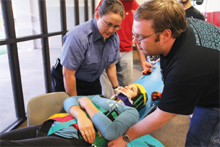Students gain emergency experience at OCCC


Rachel Morrison/Pioneer
Instructor Megan Pfeiffer shows EMS major Jason Fisher how to properly transfer fellow EMS major Jessica Leal onto a stretcher as part of training on Sept. 29.
The ambulance in the Health Professions hallway is not just for show. It’s also for training students in emergency medical sciences, said Professor Brent Stafford.
The program has been using an ambulance “since the dawn of time” or when the program started in the 1970s.
However, this is the first time the ambulance has been indoors, Stafford said.
“The previous ones were outdoors but they ran,” he said.
“So we actually moved them around. Students got to drive them and work in them, as they were moving.”
Due to liability and other concerns, plus larger class sizes, the ambulance is now conveniently inside the hallway, Stafford said.
The ambulance is used in exercises to help students practice real life simulations.
The students dress in uniforms and use everything they might use in a medical emergency.
“It provides that lifelike effect,” Stafford said.
“If you just have a classroom and a laboratory, it doesn’t put it in the right perspective.
“When you put them in the ambulance, it gives them a feel of what it is really like out there.”
Recently in Stafford’s Beginner EMS class, each student took turns being the lead paramedic.
Students were given different scenarios to manage, including a man in cardiac arrest and a man who had possibly overdosed on drugs.
The student used the skills they had acquired to assess and handle the situation as they would in real life.
It was helpful, one student said.
“I think by doing the group ambulance exercises, students are allowed to experience an emergency situation first-hand and run through all possible scenarios we could encounter in the field,” student Symbre Allen said.
“We learn basic operation of a standard ambulance, features of two different types of patient cots, and how to safely transport a patient in a high-stress situation.”
During these exercises students used the ambulance to practice loading and unloading the patient.
Unfortunately students couldn’t actually practice operating the ambulance because it has no electricity.
EMS Professor Shawn Ballard said this is a challenge.
“We are working in it to make the ambulance more functional for the students,” Ballard said.
Even without electricity, the ambulance still seemed to offer great practice for the students.
Once the patient-simulator dummy was inside the vehicle, the students gave it CRP for about the amount of time it would have taken to get to a hospital.
During this time, as they would in a real situation, the lead paramedic used the radio to call dispatch to let them know they were in route to the hospital.
Then they proceeded to call the hospital to let them know how far they were and the condition of the patient.
When asked if he thought students were more prepared because of the ambulance training, Stafford said,
“Oh absolutely, there’s no doubt about it.”
The students agreed.
“These practice scenarios allow us to be better trained, better prepared for clinicals and future job opportunities,” Allen said.
To contact Mackenzie Mann, email onlineeditor@occc.edu